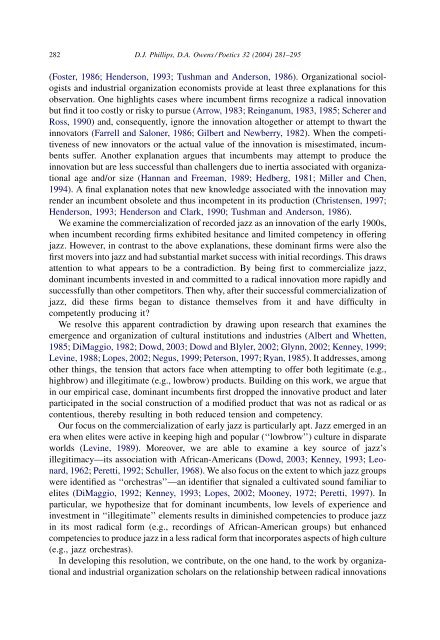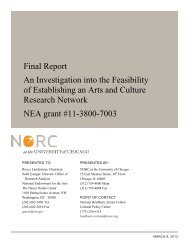Incumbents, innovation, and competence - Cultural Policy Center ...
Incumbents, innovation, and competence - Cultural Policy Center ...
Incumbents, innovation, and competence - Cultural Policy Center ...
Create successful ePaper yourself
Turn your PDF publications into a flip-book with our unique Google optimized e-Paper software.
282 D.J. Phillips, D.A. Owens / Poetics 32 (2004) 281–295<br />
(Foster, 1986; Henderson, 1993; Tushman <strong>and</strong> Anderson, 1986). Organizational sociologists<br />
<strong>and</strong> industrial organization economists provide at least three explanations for this<br />
observation. One highlights cases where incumbent firms recognize a radical <strong>innovation</strong><br />
but find it too costly or risky to pursue (Arrow, 1983; Reinganum, 1983, 1985; Scherer <strong>and</strong><br />
Ross, 1990) <strong>and</strong>, consequently, ignore the <strong>innovation</strong> altogether or attempt to thwart the<br />
innovators (Farrell <strong>and</strong> Saloner, 1986; Gilbert <strong>and</strong> Newberry, 1982). When the competitiveness<br />
of new innovators or the actual value of the <strong>innovation</strong> is misestimated, incumbents<br />
suffer. Another explanation argues that incumbents may attempt to produce the<br />
<strong>innovation</strong> but are less successful than challengers due to inertia associated with organizational<br />
age <strong>and</strong>/or size (Hannan <strong>and</strong> Freeman, 1989; Hedberg, 1981; Miller <strong>and</strong> Chen,<br />
1994). A final explanation notes that new knowledge associated with the <strong>innovation</strong> may<br />
render an incumbent obsolete <strong>and</strong> thus incompetent in its production (Christensen, 1997;<br />
Henderson, 1993; Henderson <strong>and</strong> Clark, 1990; Tushman <strong>and</strong> Anderson, 1986).<br />
We examine the commercialization of recorded jazz as an <strong>innovation</strong> of the early 1900s,<br />
when incumbent recording firms exhibited hesitance <strong>and</strong> limited competency in offering<br />
jazz. However, in contrast to the above explanations, these dominant firms were also the<br />
first movers into jazz <strong>and</strong> had substantial market success with initial recordings. This draws<br />
attention to what appears to be a contradiction. By being first to commercialize jazz,<br />
dominant incumbents invested in <strong>and</strong> committed to a radical <strong>innovation</strong> more rapidly <strong>and</strong><br />
successfully than other competitors. Then why, after their successful commercialization of<br />
jazz, did these firms began to distance themselves from it <strong>and</strong> have difficulty in<br />
competently producing it?<br />
We resolve this apparent contradiction by drawing upon research that examines the<br />
emergence <strong>and</strong> organization of cultural institutions <strong>and</strong> industries (Albert <strong>and</strong> Whetten,<br />
1985; DiMaggio, 1982; Dowd, 2003; Dowd <strong>and</strong> Blyler, 2002; Glynn, 2002; Kenney, 1999;<br />
Levine, 1988; Lopes, 2002; Negus, 1999; Peterson, 1997; Ryan, 1985). It addresses, among<br />
other things, the tension that actors face when attempting to offer both legitimate (e.g.,<br />
highbrow) <strong>and</strong> illegitimate (e.g., lowbrow) products. Building on this work, we argue that<br />
in our empirical case, dominant incumbents first dropped the innovative product <strong>and</strong> later<br />
participated in the social construction of a modified product that was not as radical or as<br />
contentious, thereby resulting in both reduced tension <strong>and</strong> competency.<br />
Our focus on the commercialization of early jazz is particularly apt. Jazz emerged in an<br />
era when elites were active in keeping high <strong>and</strong> popular (‘‘lowbrow’’) culture in disparate<br />
worlds (Levine, 1989). Moreover, we are able to examine a key source of jazz’s<br />
illegitimacy—its association with African-Americans (Dowd, 2003; Kenney, 1993; Leonard,<br />
1962; Peretti, 1992; Schuller, 1968). We also focus on the extent to which jazz groups<br />
were identified as ‘‘orchestras’’—an identifier that signaled a cultivated sound familiar to<br />
elites (DiMaggio, 1992; Kenney, 1993; Lopes, 2002; Mooney, 1972; Peretti, 1997). In<br />
particular, we hypothesize that for dominant incumbents, low levels of experience <strong>and</strong><br />
investment in ‘‘illegitimate’’ elements results in diminished competencies to produce jazz<br />
in its most radical form (e.g., recordings of African-American groups) but enhanced<br />
competencies to produce jazz in a less radical form that incorporates aspects of high culture<br />
(e.g., jazz orchestras).<br />
In developing this resolution, we contribute, on the one h<strong>and</strong>, to the work by organizational<br />
<strong>and</strong> industrial organization scholars on the relationship between radical <strong>innovation</strong>s









